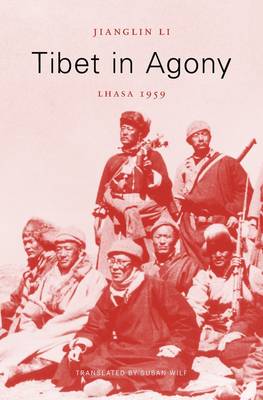5%OFF

Stock image for illustration purposes only - book cover, edition or condition may vary.
Tibet in Agony: Lhasa 1959
Jianglin Li
€ 46.99
€ 44.49
FREE Delivery in Ireland
Description for Tibet in Agony: Lhasa 1959
Hardback. Jianglin Li provides the first clear historical account of the Chinese crackdown in Lhasa in 1959. Sifting facts from the distortions of propaganda and partisan politics, she reconstructs a chronology of events that answers lingering questions and tells a gripping story of a crisis whose aftershocks continue to rattle the region today. Translator(s): Wilf, Susan. Num Pages: 372 pages, 30 halftones, 7 maps. BIC Classification: 1FKN; 1FPCT; HBJF; HBLW. Category: (G) General (US: Trade). Dimension: 245 x 164 x 36. Weight in Grams: 858.
The Chinese Communist government has twice invoked large-scale military might to crush popular uprisings in capital cities. The second incident--the notorious massacre in Tiananmen Square in 1989--is well known. The first, thirty years earlier in Tibet, remains little understood today. Yet in wages of destruction, bloodshed, and trampling of human rights, the tragic toll of March 1959 surpassed Tiananmen. Tibet in Agony provides the first clear historical account of the Chinese crackdown in Lhasa. Sifting facts from the distortions of propaganda and partisan politics, Jianglin Li reconstructs a chronology of events that lays to rest lingering questions about what happened in those fate-filled days and why. Her story begins with throngs of Tibetan demonstrators who--fearful that Chinese authorities were planning to abduct the Dalai Lama, their beloved leader--formed a protective ring around his palace. On the night of March 17, he fled in disguise, only to reemerge in India weeks later to set up a government in exile. But no peaceful resolution awaited Tibet. The Chinese army soon began shelling Lhasa, inflicting thousands of casualties and ravaging heritage sites in the bombardment and the infantry onslaught that followed. Unable to resist this show of force, the Tibetans capitulated, putting Mao Zedong in a position to fulfill his long-cherished dream of bringing Tibet under the Communist yoke. Li's extensive investigation, including eyewitness interviews and examination of classified government records, tells a gripping story of a crisis whose aftershocks continue to rattle the region today.
Product Details
Publisher
Harvard University Press
Format
Hardback
Publication date
2016
Condition
New
Weight
858g
Number of Pages
372
Place of Publication
Cambridge, Mass, United States
ISBN
9780674088894
SKU
V9780674088894
Shipping Time
Usually ships in 4 to 8 working days
Ref
99-2
About Jianglin Li
Jianglin Li is an independent scholar and writer who specializes in post-1950 Tibetan history and the Tibetan diaspora.
Reviews for Tibet in Agony: Lhasa 1959
Should be required reading.
Jonathan Mirsky The Spectator (10/01/2016) This remarkable book is told with the narrative force of a compelling novel. Exposing the violence of the 'peaceful liberation' and the myth of 'democratic reform, ' Li's excavation of Tibet's agony in the 1950s reveals that Mao hoped for the Tibetans to rise up in order to crush them and bring Tibet under Communist control. This pathbreaking book involved not only painstaking research into sources that have not been made public in English before, but also personal sacrifice by the author, who now lives in exile.
Kate Saunders, Director of Communications, International Campaign for Tibet Remarkable...for its meticulously researched and detailed expos of Chinese duplicity and ruthlessness...What you hear turning every page of this book
the first book written with full access to official Chinese documents and accounts of the events
is the sound of scales falling from the eyes.
Mick Brown Literary Review (10/01/2016) Through her meticulous research and engaging narrative, Li is the first to convincingly reconstruct the events that forced the Dalai Lama to escape from Tibet. This pathbreaking book helps us understand why the violence of 1959 still resonates to this day.
Frank Dik tter, author of Mao's Great Famine A wonderful combination of really good storytelling and meticulous, painstaking research. We are left with a much more thorough understanding of what must have happened in the weeks before and after the Dalai Lama's escape as well as a new certainty that there is much we will never know
or understand
for sure.
Anne F. Thurston, coauthor of The Noodle Maker of Kalimpong
Jonathan Mirsky The Spectator (10/01/2016) This remarkable book is told with the narrative force of a compelling novel. Exposing the violence of the 'peaceful liberation' and the myth of 'democratic reform, ' Li's excavation of Tibet's agony in the 1950s reveals that Mao hoped for the Tibetans to rise up in order to crush them and bring Tibet under Communist control. This pathbreaking book involved not only painstaking research into sources that have not been made public in English before, but also personal sacrifice by the author, who now lives in exile.
Kate Saunders, Director of Communications, International Campaign for Tibet Remarkable...for its meticulously researched and detailed expos of Chinese duplicity and ruthlessness...What you hear turning every page of this book
the first book written with full access to official Chinese documents and accounts of the events
is the sound of scales falling from the eyes.
Mick Brown Literary Review (10/01/2016) Through her meticulous research and engaging narrative, Li is the first to convincingly reconstruct the events that forced the Dalai Lama to escape from Tibet. This pathbreaking book helps us understand why the violence of 1959 still resonates to this day.
Frank Dik tter, author of Mao's Great Famine A wonderful combination of really good storytelling and meticulous, painstaking research. We are left with a much more thorough understanding of what must have happened in the weeks before and after the Dalai Lama's escape as well as a new certainty that there is much we will never know
or understand
for sure.
Anne F. Thurston, coauthor of The Noodle Maker of Kalimpong
